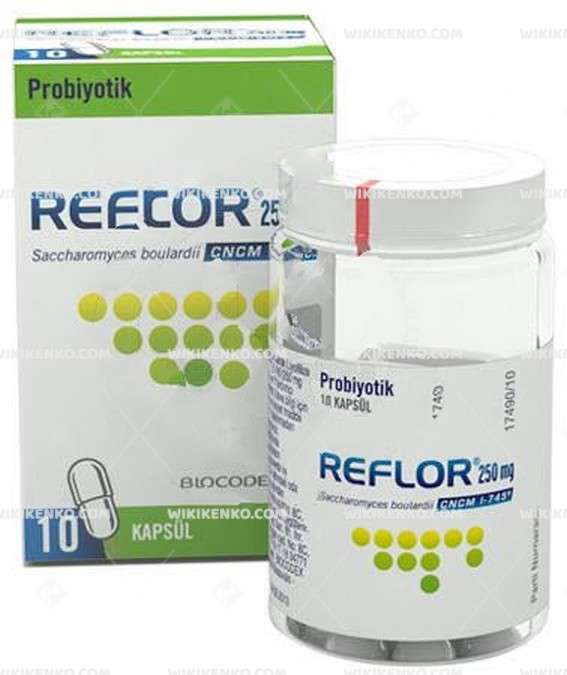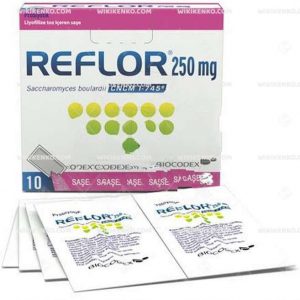Reflor Capsule
When it comes to gastrointestinal health, having the right information at your fingertips is essential. In this comprehensive guide, we delve into Reflor Capsule, shedding light on its composition, uses, dosage, side effects, storage, and safety considerations.
| Dosage form | |
|---|---|
| Pack size | |
| Potency | 250 Mg |
| Manufacturer | |
| Origin | |
| Generic Name (Ingredient) | Lyophilized Saccharomyces Boulardii (Equivalent To 250 Mg Yeast) 282.50 Mg |
Assuming your emergency circumstances for this product, visit Urgent Quotation page. Besides, for any pharmaceutical questions, please ask us in the comments section.
Description
Reflor is a non-prescription medication with a remarkable role in preventing and treating diarrhea stemming from various causes. Whether it’s microbial, bacterial, or antibiotic-induced diarrhea, Reflor has proven efficacy. Additionally, it plays a crucial role in addressing rotavirus-induced diarrhea in children. The key player in Reflor’s effectiveness is Saccharomyces boulardii, a probiotic yeast renowned for its intestinal-friendly properties and pathogen-neutralizing abilities.
Forms and Varieties
Reflor comes in two convenient forms: capsules and sachets. Each Reflor capsule contains 250 mg of lyophilized Saccharomyces boulardii, equivalent to 250 mg of yeast. The capsules are available in bottles containing 10, 20, 30, or 50 capsules.
Uses
Reflor’s versatility shines through in its wide range of applications, including:
1. Diarrhea in Tube-Fed Patients
For individuals reliant on tube feeding, Reflor offers a solution to manage diarrhea effectively.
2. Rotavirus-Induced Diarrhea in Infants and Children
In the realm of pediatric care, Reflor stands as a trusted ally in combating rotavirus-induced diarrhea, a common challenge in young children.
3. Antibiotic-Related Diarrhea
When antibiotics disrupt the delicate balance of intestinal flora, Reflor steps in to restore harmony.
4. Clostridium difficile-Associated Diarrhea
In partnership with antibiotics, Reflor combats diarrhea caused by the notorious Clostridium difficile bacteria.
5. HIV-Related Diarrhea
For individuals facing the complexities of HIV-related health concerns, Reflor aids in managing associated diarrhea.
6. Traveler’s Diarrhea
Travelers, too, benefit from Reflor’s ability to address the often-unpredictable occurrence of diarrhea during journeys.
7. Acne and Helicobacter pylori Treatment
Reflor’s applications extend beyond gastrointestinal health to assist in acne treatment and as a valuable companion to standard H. pylori therapy. It helps mitigate side effects such as diarrhea and nausea during treatment.
Mechanism of Action
At the heart of Reflor’s effectiveness lies Saccharomyces boulardii, a probiotic yeast that becomes a friendly force within the intestines. It functions akin to the beneficial bacteria in our bodies, countering harmful bacteria and pathogens in the gastrointestinal system.
Optimal Use
To maximize the effectiveness of Reflor, consider the following recommendations:
- Reflor can be taken at any time of the day, but for expedited results, avoid taking it with meals.
- Steer clear of consuming Reflor alongside very hot or very cold foods and drinks.
- Refrain from combining Reflor with alcoholic beverages.
Precautions
Reflor boasts a favorable safety profile with minimal side effects. However, prudence dictates consulting your doctor or pharmacist before use. If you fall into any of the following categories, exercise caution:
- Pregnant or breastfeeding women should seek medical guidance before using Reflor.
- Individuals with liver or kidney conditions or known antibiotic allergies should inform their healthcare provider prior to commencing Reflor treatment.
Dosage
The appropriate dosage of Reflor varies depending on the specific condition being treated. In adults, Saccharomyces boulardii, Reflor’s active ingredient, is typically administered orally at doses ranging from 500 to 1000 mg, equivalent to approximately 10 to 20 billion colony-forming units, daily for four weeks. Always adhere to the instructions provided on the product packaging and consult your healthcare professional for precise details.
Reflor Capsule Side Effects
While side effects from Reflor are infrequent, they may include:
- Epigastric disturbances: Characterized by discomfort or pain in the upper abdomen.
- Abdominal meteorism: Referring to excessive gas in the intestines, potentially causing bloating and discomfort.
- Signs of infection: Although rare, persistent symptoms such as cough, high fever, or chills warrant immediate medical attention.
This list represents potential side effects, and not everyone may experience them. If any other effects not mentioned here manifest, promptly contact your doctor or pharmacist. If you have a known or suspected hypersensitivity to the product, Reflor is contraindicated.
Timeframe for Reflor’s Efficacy
The precise onset of action for Reflor may vary depending on the individual and the specific condition being treated. Generally, probiotics like Saccharomyces boulardii, the active ingredient in Reflor, begin to take effect within a few hours to a few days. However, for personalized information tailored to your unique circumstances, it is advisable to consult with a healthcare provider.
Storage
Preserving the integrity and efficacy of Reflor Capsules necessitates proper storage. Key considerations include:
- Temperature control: Maintain a storage temperature not exceeding 25°C. Extreme temperatures, as may occur during transit or storage, can jeopardize shelf life and expiry dates.
- Environmental factors: Factors such as temperature, air quality, light exposure, and humidity play vital roles in maintaining drug stability.
- Storage area: Ensure your storage area has sufficient capacity to orderly accommodate various materials and products.
Always store medications out of reach of children. For specific queries regarding Reflor Capsules’ storage, consult your healthcare provider or pharmacist.
Shelf Life
The precise shelf life of Reflor Capsules is not explicitly stated in available sources. Manufacturers commonly assign a two- to three-year shelf life to their products, ensuring the integrity of medications on pharmacy shelves. However, for accurate information tailored to your circumstances, consult your healthcare provider or pharmacist.
Pregnancy
Pregnant women should exercise caution when considering Reflor use. While human studies are limited, animal studies have demonstrated potential risks to developing fetuses. Not all medications are safe during pregnancy, and it is essential for your doctor to weigh the benefits against potential risks before prescribing Reflor. Always consult with your healthcare professional for medical advice regarding medication use during pregnancy.
In Conclusion
In conclusion, Reflor Capsule emerges as a valuable ally in the quest for gastrointestinal well-being. Its multifaceted applications, minimal side effects, and probiotic prowess make it a compelling choice for addressing a range of diarrhea-related challenges. However, responsible use and medical consultation are paramount. When it comes to your health, informed decisions guided by healthcare professionals ensure the best outcomes.
Essential Information
| Aspect | Information |
|---|---|
| Active Ingredient | Saccharomyces boulardii (250 mg per capsule) |
| Available Forms | Capsules and sachets |
| Primary Uses | Diarrhea management and prevention |
| Precautions | Pregnant or breastfeeding women, liver or kidney conditions, known antibiotic allergies |
| Dosage | Adults: 500-1000 mg (10-20 billion CFUs) daily for 4 weeks |
| Side Effects | Epigastric disturbances, abdominal meteorism, signs of infection |
| Storage Conditions | Temperature not exceeding 25°C, protect from extreme temperatures |
| Shelf Life | Typically two to three years, consult healthcare provider or pharmacist for specifics |
| Pregnancy Considerations | Caution advised, consult healthcare provider for guidance |
Use the form below to report an error
Please answer the questions as thoroughly and accurately as possible. Your answers will help us better understand what kind of mistakes happen, why and where they happen, and in the end the purpose is to build a better archive to guide researchers and professionals around the world.
The information on this page is not intended to be a substitute for professional medical advice, diagnosis, or treatment. always seek the advice for your physician or another qualified health provider with any questions you may have regarding a medical condition. Always remember to
- Ask your own doctor for medical advice.
- Names, brands, and dosage may differ between countries.
- When not feeling well, or experiencing side effects always contact your own doctor.
Cyberchondria
The truth is that when we’re sick, or worried about getting sick, the internet won’t help.
According to Wikipedia, cyberchondria is a mental disorder consisting in the desire to independently make a diagnosis based on the symptoms of diseases described on Internet sites.
Why you can't look for symptoms on the Internet
If diagnoses could be made simply from a textbook or an article on a website, we would all be doctors and treat ourselves. Nothing can replace the experience and knowledge of specially trained people. As in any field, in medicine there are unscrupulous specialists, differences of opinion, inaccurate diagnoses and incorrect test results.




Reviews
There are no reviews yet.